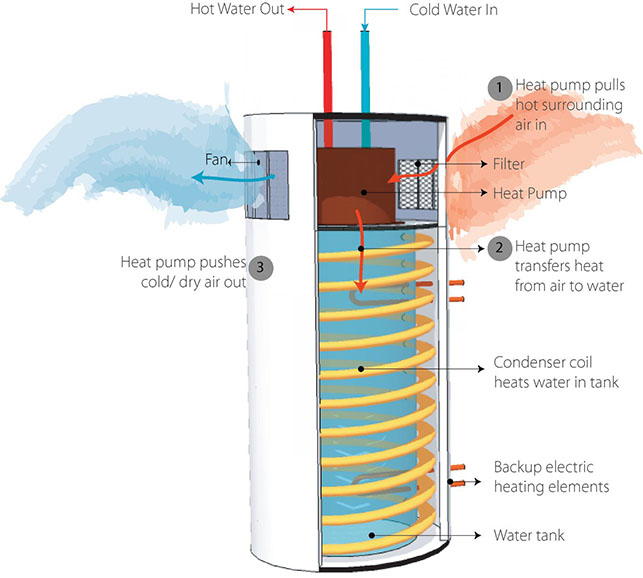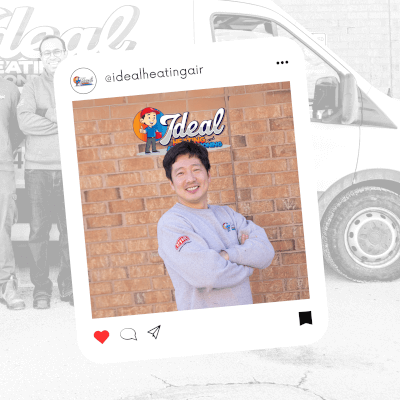Looking for a smarter, more sustainable way to heat water in your Toronto home? A heat pump water heater (often shortened to HPWH) could be the perfect solution. These systems are growing in popularity across Ontario thanks to their impressive efficiency, reduced carbon footprint, and enticing local rebate programs.
Here’s everything you need to know about how heat pump water heaters work, how they compare to traditional systems, and what rebates are available for homeowners in the GTA.
- What is a Heat Pump Water Heater?
- Energy Use and Environmental Impact
- Heat Pump Water Heaters vs. Other Products
- Toronto Rebates for Heat Pump Water Heaters
- Planning an Installation
If you want quick, direct tips on whether a heat pump water heater is the best choice for your home, give us a call at Ideal Heating, and we’ll provide you with a free, no-obligation quote.
What is a Heat Pump Water Heater?
A heat pump water heater (HPWH) is a highly efficient alternative to traditional water heating systems. Instead of using electricity or gas to generate heat directly, it uses electricity to move heat from the air into the water tank—making it far more energy-efficient.
Here’s how it works: The system draws in air from the surrounding environment using a fan. That air passes over evaporator coils filled with refrigerant, which absorbs the heat. The refrigerant is then compressed to increase its temperature, and the resulting heat is transferred to the water inside the tank. The cooled air is then vented back out. This process is similar to how refrigerators or air conditioners operate—but in reverse.
Key Components:
Fan and evaporator coil: Pull in warm air and absorb its heat.
Compressor: Raises the temperature of the absorbed heat.
Heat exchanger: Transfers heat to the stored water.
Storage tank: Holds the hot water, just like a conventional tank-style heater.
Because it captures and amplifies ambient heat rather than generating it, a heat pump water heater can deliver the same amount of hot water using a fraction of the energy required by electric resistance or gas-fired systems.

Most standard heat pump water heaters operate like the diagram above. Source.
Hybrid Functionality
Many heat pump water heaters are hybrid models, meaning they include a backup electric resistance element. This ensures a steady supply of hot water during high-demand periods or when the surrounding air is too cold to draw heat efficiently. Users can typically select from multiple modes (e.g., Energy Saver, Hybrid, or High Demand), giving them flexibility based on their usage and climate conditions.
Installation Considerations
Heat pump water heaters work best in spaces where the surrounding air remains relatively warm and there’s enough room for air circulation—like basements, utility rooms, or mechanical areas. Because they cool and dehumidify the air around them, they can even help regulate basement humidity in the summer.
Energy Use and Environmental Impact
Compared to conventional electric or gas-powered water heaters, heat pump models are dramatically more energy-efficient. Most other water heaters come with drawbacks, such as:
Electric Resistance Water Heaters: These use electricity to directly heat water, making them costly over time.
Gas Water Heaters: These offer faster recovery times but rely on fossil fuels and produce greenhouse gases.
Tankless Water Heaters: Great for saving space and energy, but their efficiency is still below that of a heat pump heater when used in the right conditions.
Because they pull ambient heat from the air, heat pump water heaters are especially efficient and can cut your water heating costs by up to 50%. Keep in mind they’re most effective in spaces where the surrounding air stays between 4°C and 32°C, like basements, utility rooms, or heated garages.
Heat Pump Water Heaters vs. Other Products
When choosing a water heater for your home, it’s important to weigh your options based on energy efficiency, cost, performance, and environmental impact. Heat pump water heaters are gaining popularity across Ontario, but how do they stack up against other systems like traditional electric, natural gas, tankless, and solar water heaters?
Here’s a breakdown of the most common types:
1. Electric Resistance Water Heaters
These are traditional tank-style heaters that use electric coils to heat water directly.
Pros:
Low upfront cost
Widely available and easy to install
Works in any indoor environment
Cons:
High operating costs over time due to energy inefficiency
Uses significantly more electricity than a heat pump system
No cooling or dehumidifying benefit
Comparison: A heat pump water heater can use 50–70% less electricity than a standard electric model, making it a much more cost-effective choice over the long term—even if the initial cost is higher.
2. Natural Gas Water Heaters
These use gas burners to heat water, and are common in Toronto homes that already use natural gas for heating.
Pros:
Lower operating costs than electric models (especially in gas-heated homes)
Faster water recovery times
Generally reliable and consistent
Cons:
Relies on fossil fuels, contributing to greenhouse gas emissions
Risk of gas leaks or carbon monoxide exposure
Ventilation requirements add complexity to installation
Comparison: While gas heaters may have a slight edge on performance in cold climates, heat pump water heaters are significantly cleaner from an environmental standpoint, especially in Ontario, where the electricity grid is relatively low-emission. And with rebates, the cost difference is shrinking.
3. Tankless (On-Demand) Water Heaters
Tankless units heat water instantly as needed, without storing it in a tank.
Pros:
Endless hot water supply
Compact and space-saving
More efficient than traditional electric or gas tank systems
Cons:
High upfront cost
May struggle with multiple simultaneous hot water demands (e.g., two showers + dishwasher)
Complex installation, especially for gas-powered models
Comparison: Tankless systems offer excellent performance, especially in smaller households. However, heat pump water heaters typically have lower ongoing energy costs in homes with moderate water demand, and also provide storage capacity that tankless units lack.
4. Solar Water Heaters
These systems use rooftop solar collectors to heat water, often with a backup system for cloudy days.
Pros:
Extremely low operating costs once installed
Environmentally friendly
Great for long-term energy savings
Cons:
High upfront investment
Requires space and optimal solar exposure
May not be practical for many urban Toronto homes
Comparison: Solar heaters are the greenest option available—but they’re not always realistic for every homeowner (if you do want to learn more about the considerations involved in solar water heating, this guide by Natural Resources Canada is a great place to start) . A heat pump water heater offers a strong balance of energy efficiency, affordability, and ease of installation, especially for urban or suburban households.
Summary: Why Choose a Heat Pump Water Heater?
| System Type | Upfront Cost | Efficiency | Carbon Footprint | Ideal For |
|---|---|---|---|---|
| Heat Pump Water Heater | Moderate | ★★★★☆ | ★★★★☆ | Energy-conscious homeowners with some space |
| Electric Resistance | Low | ★★☆☆☆ | ★★☆☆☆ | Budget-focused installs |
| Natural Gas | Moderate | ★★★☆☆ | ★★☆☆☆ | Homes already using gas |
| Tankless (On-Demand) | High | ★★★★☆ | ★★★☆☆ | Small households or tight spaces |
| Solar | Very High | ★★★★★ | ★★★★★ | Eco-focused homes with solar potential |
Conclusion: While each system has its place, heat pump water heaters offer the best blend of efficiency, cost savings, and eco-friendliness for most Toronto homes—especially when you take into account local rebates that help offset installation costs.
Toronto Rebates for Heat Pump Water Heaters
The good news? There are rebates and incentives available to help cover the cost of a new heat pump water heater.
As of 2025, homeowners may be eligible for the following programs:
Enbridge Gas Home Efficiency Rebate Plus (HER+): Offers up to $1,300 back when installing an ENERGY STAR® certified heat pump water heater, especially when combined with other upgrades like insulation or HVAC improvements.
Canada Greener Homes Initiative (partly phasing out, but some opportunities still exist): May include partial rebates for energy-efficient upgrades, including water heaters, depending on availability.
Toronto-specific programs: The City of Toronto occasionally offers various incentives for low-carbon technologies—check with your contractor or Ideal Heating for the latest updates.
Tip: You usually need to complete an energy audit before and after installation to qualify for these rebates. Ideal Heating can help coordinate this process.
Planning an Installation
Thinking about making the switch to a heat pump water heater? Planning ahead can help ensure a smooth, stress-free installation—and maximize your energy savings from day one.
Here’s what you should consider before installing a new system in your Toronto-area home:
1. Examine Your Space
Heat pump water heaters need a bit more breathing room than conventional systems. Ideally, they should be installed in:
A basement, utility room, or mechanical room with at least 700–1,000 cubic feet of air space
A location that stays between 4°C and 32°C year-round
An area with proper ventilation to allow for air circulation and optional ducting
Tip: HPWHs release cool, dry air during operation, which can help reduce basement humidity in summer months.
2. Check Your Electrical Requirements
Most heat pump water heaters require a 240V circuit, just like standard electric tanks. A licensed installer will confirm whether your home’s electrical panel has capacity or needs an upgrade.
3. Book an Energy Audit (If Rebates Apply)
To qualify for many Ontario rebate programs (like Enbridge HER+), you’ll need to schedule:
A pre-retrofit EnerGuide home energy assessment before installation
A post-retrofit assessment after the work is done
A certified energy advisor can guide you through the paperwork and ensure you meet all eligibility criteria for rebates.
4. Work with a Qualified Installer
This is where the right HVAC company makes all the difference.
Ideal Heating is a trusted, independently owned HVAC company serving Toronto and the GTA. Our team of trained, friendly specialists will walk you through every step—from helping you choose the right model to handling the installation, electrical needs, and rebate paperwork.
With transparent pricing, excellent reviews, and a strong commitment to service, Ideal Heating makes the water heater installation process simple, honest, and hassle-free.





